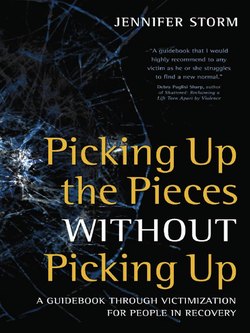Читать книгу Picking Up the Pieces without Picking Up - Jennifer Storm - Страница 8
На сайте Литреса книга снята с продажи.
ОглавлениеPreface
I am a crime victim/survivor a few times over. When I was twelve I was a raped by a man who was twenty-eight years old. That night was the first time I ever had a drink in my life, and I was hooked the minute the fluid hit my lips. I wound up blacking out, and a night of innocent roller skating turned into the single worst night of my life. The crime and its aftermath took my life and twisted it into something I didn’t recognize. When I looked in the mirror I no longer knew the reflection looking back. Everything I knew had been shattered, and there were pieces of my former life all over the floor around me and my family. My brother, my parents, and I walked carefully among these shards, fearful that we might find a sharp edge and cut ourselves deeper than we had already been injured. Our home became a live land mine, and none of us knew how to walk around normally anymore.
I had no methods, resources, or understanding of how to begin to heal. I was so lost, and the fact that alcohol was involved in my victimization only fueled the guilt train I jumped on immediately. Instead of turning away from alcohol, I ran toward it. It became the solution to my problems, not the source. I didn’t ease into addiction like some do over years and years of social use—I slammed into it.
My active addiction went on into my teenage years and early twenties. Of course, living a lifestyle of drinking until blackout or running the streets in the middle of the night to purchase illegal drugs led me straight into additional victimization. For many years I had a hard time deciphering what was truly my role in the victimization. It wasn’t until I found recovery by going to a rehabilitation center that I realized that no one had the right to harm me, regardless of what I was doing. My addiction and victimization were so intertwined that it took me a long time in recovery to untwist all my false understandings and come to a place of peace and forgiveness with it all.
I wound up going to college to become a drug and alcohol counselor. I wanted to give back what I had found, which was a way of life I never knew was possible. It was a life free from addiction and full of possibility. As I progressed in college I began to learn about victims’ rights, a concept that was foreign to me. I never knew crime victims had rights. Even as a victim, I had never had anyone educate me on these things. I learned that in the early 1980s a movement brought about a bill of rights for crime victims, and that each state in the nation had its own version of these rights.
I was intrigued, and upon graduation I sought a position working to create change for crime victims in my state. I lobbied for legislation and did a lot of educational planning in my first job as managing director of a statewide coalition. I was then hired as the executive director of a nonprofit organization that provides direct services to crime victims in Dauphin County, Harrisburg, Pennsylvania. The Victim/ Witness Assistance Program provides services to more than eight thousand victims each year, and I am in my eighth year working with this amazing program. It was in my work with this agency that I began to discover how much victims’ services had to offer. In my first year I responded to more than twenty homicides; provided death notification, crisis intervention, and supportive counseling; assisted with body identification and transfer; and linked families and loved ones to victims’ compensation. I’ve worked with victims of theft, rape, domestic violence, homicide, assault, and other crimes.
I wanted to write this book not only from the viewpoint of a survivor of crime, but as a person in recovery and as an executive director of a program that works directly with crime victims. So often when my agency is working with clients, we discover that substance abuse or addiction is an underlying factor—whether the client is struggling or the offender was addicted at the time of the crime. I wanted to create an easy-to-follow guide that would allow people to understand not only the trauma they are experiencing, but also how the criminal justice system works and is expected to treat them. Additionally, I felt a strong need to address the co-occurring substance abuse issues.
When attempting to heal from victimization, it is easy to fall back into old patterns of addiction, or, if you’ve never experienced problems with alcohol and other drugs, to now find yourself using substances to cope. This book is intended to serve as an educational resource that will walk you through your pain, help you navigate the criminal justice system, and give you helpful guidance on dealing and healing. As a survivor myself, I wish a resource like this had been available when I needed it. I am humbled to be in a position to provide this guide to you, and I hope it helps you as we all trudge along this journey together in one way or another. May peace be with you.
